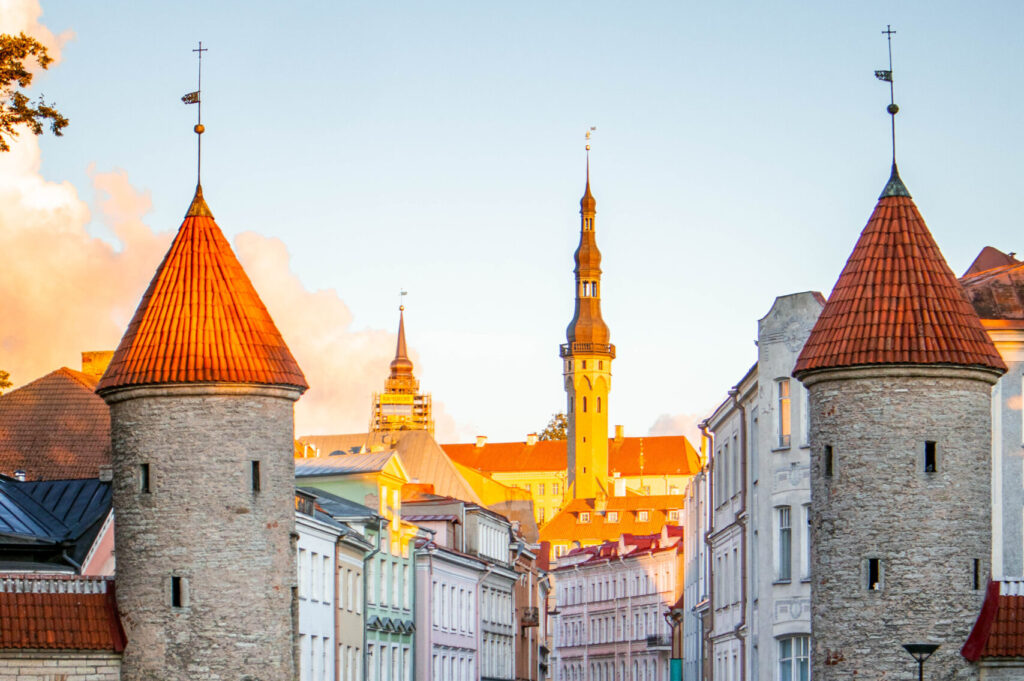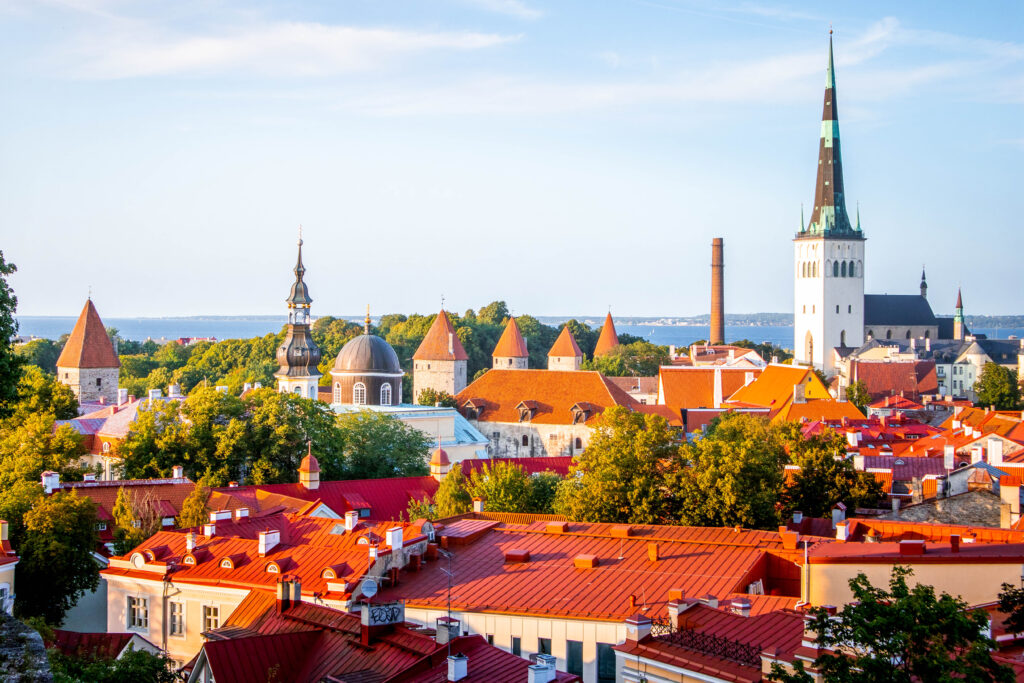VISIT Estonia
Where medieval meets modern, Estonia blends centuries-old cities, digital innovation, and wild, forested landscapes. It’s a Baltic gem for slow travellers and nature lovers alike.
Currency
€ - Euro (1€ ≃ 1,05$ ≃0,86£)
POPULATION
1,3 millions
MAIN LANGUAGE
Estonian
AREA
45,339 km²
TIME ZONE
UTC+2 / UTC+3
FLAG
🇪🇪
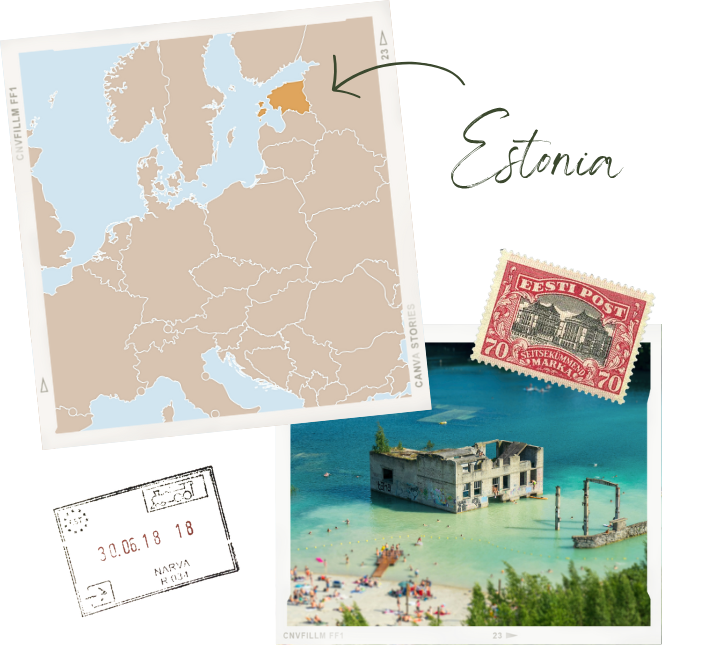

HANG OUT IN TARTU
In addition to having one of the oldest universities in Northern Europe, Tartu is home to numerous museums and a vibrant nightlife.

HIKE IN LAHEMAA NATIONAL PARK
Located on the northern coast of the country, Lahemaa is ideal for hiking and observing Estonian nature: rocky and sandy beaches, scenic bogs, pine and cliff woods, and rivers that carve into limestone cliffs.

TRAVEL TIME IN TALLINN
At the edge of the Baltic Sea, Tallinn is the capital and the cultural centre of Estonia. It has retained its cobbled old town surrounded by ramparts and a Gothic town hall built in the 13th century.

DO SOME ESTONIAN ISLAND HOPPING
The most well-known Estonian islands are Saaremaa, Hiiumaa, Kihnu, Ruhnu, and Vormsi. Estonia's various islands offer a great deal of charm and old history.

CLIMB AND SWIM IN RUMMU QUARRY
The Rummu Quarry's pristine, pale blue lagoon and the nearby Ash Hill make for a fascinating pairing and an excellent day trip location.
Pick an Estonian destination
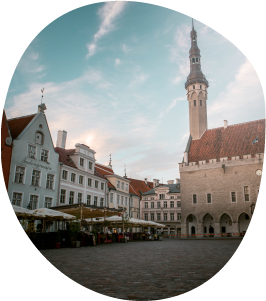
Tallinn
Capital of Estonia, with a fairytale-like medieval Old Town and a strong digital culture.

Tartu
Estonia’s intellectual heart, home to the country’s oldest university and a lively student vibe.

Lahemaa NP
Estonia’s oldest national park, offering forests, bogs, and historic manors by the Baltic coast.
Prepare your trip to Estonia
💡 Why visit Estonia?
Estonia is a Baltic gem where medieval charm meets modern innovation. From the cobbled streets of Tallinn’s UNESCO-listed Old Town to its pristine forests and digital-savvy culture, Estonia offers a unique travel experience. Must-see highlights include Tallinn’s fairytale architecture, the bog landscapes of Soomaa National Park, and the quiet beauty of Saaremaa island.
🪪 Do I need a visa to visit Estonia?
Estonia is part of the Schengen area. Citizens of the EU, USA, Canada, Australia, and many other countries can enter visa-free for up to 90 days within a 180-day period. However, some nationalities do require a visa. It’s best to check with the nearest Estonian embassy or consulate for the most up-to-date information specific to your situation.
IMPORTANT NOTE: The information below is provided merely as an indication and applies for short-term tourism visa purposes only. Before your trip to Estonia, or if you are planning to come to Estonia for another purpose (work, studies, …), check the official information on the European Commission website’s page about Schengen visa application: https://www.home-affairs.ec.europa.eu/
⏳ Visa-free but limited to maximum 90 days for a period of 180 days if you are a citizen of one of the following countries: Albania; Andorra; Antigua and Barbuda; Argentina; Australia; Austria; Bahamas; Barbados; Belgium; Bosnia and Herzegovina; Brazil; Brunei; Bulgaria; Canada; Chile; Colombia; Costa Rica; Croatia; Czechia; Denmark; Dominica; El Salvador; Estonia; Finland; France; Georgia; Germany; Greece; Grenada; Guatemala; Honduras; Hong Kong; Hungary; Iceland; Israel; Italy; Japan; Kiribati; Kosovo; Latvia; Liechtenstein; Lithuania; Luxembourg; Macau; Malaysia; Malta; Marshall Islands; Mauritius; Mexico; Micronesia; Moldova; Monaco; Montenegro; Netherlands; New-Zealand; Nicaragua; North Macedonia; Norway; Palau; Panama; Paraguay; Peru; Poland; Portugal; Romania; Saint Kitts and Nevis; Saint Lucia; Saint Vincent and the Grenadines; Samoa; San Marino; Serbia; Seychelles; Singapore; Slovakia; Slovenia; Solomon islands; South Korea; Spain; Sweden; Switzerland; Taiwan; Timor-Leste; Tonga; Trinidad and Tobago; Tuvalu; Ukraine; United Arab Emirates; United Kingdom; United States of America; Uruguay; Vatican; Venezuela
🛂 Visa required if you are a citizen of one of the following countries: Afghanistan; Algeria; Angola; Armenia; Azerbaijan; Bahrain; Bangladesh; Belarus; Belize; Benin; Bhutan; Bolivia; Botswana; Burkina Faso; Burundi; Cambodia; Cameroon; Cape Verde; Central African Republic; Chad; China; Comoros; Congo; Congo (Dem. Rep); Cote d’Ivoire (Ivory Coast); Cuba; Djibouti; Dominican Republic; Ecuador; Egypt; Equatorial Guinea; Eritrea; Eswatini; Ethiopia; Fiji; Gabon; Gambia; Ghana; Guinea; Guinea-Bissau; Guyana; Haiti; India; Indonesia; Iran; Iraq; Jamaica; Jordan; Kazakhstan; Kenya; Kuwait; Kyrgyzstan; Laos; Lebanon; Lesotho; Liberia; Libya; Madagascar; Malawi; Maldives; Mali; Mauritania; Mongolia; Morocco; Mozambique; Myanmar; Namibia; Nauru; Nepal; Niger; Nigeria; North Korea; Oman; Pakistan; Palestine; Papua New Guinea; Philippines; Qatar; Russia; Rwanda; Sao Tome and Principe; Saudi Arabia; Senegal; Sierra Leone; Somalia; South Africa; South Sudan; Sri Lanka; Sudan; Suriname; Syria; Tajikistan; Tanzania; Thailand; Togo; Tunisia; Turkey; Turkmenistan; Uganda; Uzbekistan; Vanuatu; Vietnam; Yemen; Zambia; Zimbabwe
⛅ When is the best time to visit Estonia?
❄️ December – February: Winter is cold and often damp, but festive, especially in cities like London and Bath. Temperatures range from 1°C (34°F) to 8°C (46°F). Snow is rare but possible in northern or rural areas.
🌱 March – May: Spring sees blooming gardens and milder weather. It’s a lovely time to visit with fewer crowds and longer daylight. Temperatures range from 8°C (46°F) to 16°C (61°F).
☀️ June – August: Summer is the warmest and busiest season. Expect temperatures between 15°C (59°F) and 25°C (77°F), with long days and plenty of festivals. It’s ideal for exploring cities, countryside, and the coast.
🍂 September – November: Autumn offers cooler temperatures and beautiful foliage, especially in national parks. Crowds ease and prices drop, making it a pleasant time for travel.
🚉 How to get around Estonia?
Getting around Estonia is easy, especially with its compact size and efficient transport:
🚌 Buses: The bus network is excellent and connects all major towns and cities. Services are affordable, comfortable, and punctual. Tallinn, Tartu, and Pärnu are well linked.
🚂 Trains: Trains are reliable and connect key cities like Tallinn, Tartu, and Narva. Though not as extensive as the bus system, they offer a scenic and relaxed way to travel.
🚗 Car Rental: Renting a car is a convenient way to explore national parks and the islands. Roads are in good condition, and traffic is generally light. An International Driving Permit (IDP) is recommended if your license is not in Latin script.
💳 Can I use bank cards or cash for payments in Estonia?
Estonia is one of the most digitally advanced countries in the world. Card payments are accepted almost everywhere, even in small cafés or street stalls. Cash is rarely needed, but euros (EUR) are the official currency.
🔌 What type of plugs and voltage does Estonia use?
Estonia uses plug types C and F, both with two round pins. The standard voltage is 230V and the frequency is 50Hz.
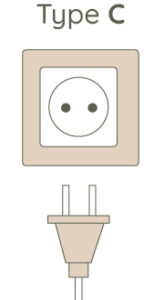
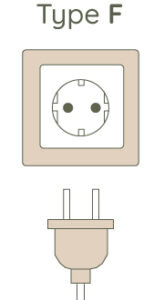
If needed, you can order an universal travel plug adapter here.
🪙 Is tipping customary in Estonia?
Tipping is not obligatory in Estonia, but it is appreciated. In restaurants and cafés, a tip of 5–10% is common if service is good.
🥛 Is it safe to drink tap water in Estonia?
Tap water is safe to drink throughout Estonia.
📅 When are public holidays and store closing days in Estonia?
In Estonia, most stores are open on Sundays, though with reduced hours. There are 9 national public holidays in Estonia:
- New Year’s Day (January 01)
- Independance Day (February 24)
- Good Friday and Easter Monday (dates vary)
- Spring Day (May 01)
- Victory Day (June 23)
- Midsummer Day (June 24)
- Restoration of Independence Day (August 20)
- Christmas Day (December 25)
- Boxing Day (December 26)
On these days, most businesses and offices will be closed, and many attractions may be shut or have limited opening hours.
🚦 What are the speed limits in Estonia?
In Estonia, traffic drives on the right-hand side of the road. The main speed limits are as follows:
- 50 kph / 30 mph in urban areas
- 90 kph / 56 mph on open roads
- 110 mph / 68 kph on motorways (only in summer and on designated roads)
During adverse weather (rain, fog, etc.), the speed limits are lowered.
💬 What are some basic Estonian words I should know?
- Hello (informal) = Tere
- Good day = Tere päevast
- Goodbye = Nägemist
- Yes = Jah
- No = Ei
- Thank you = Aitäh
- Please = Palun
- You’re welcome = Pole tänu väärt
- Excuse me = Vabandust
- Day = Päev
- Night = Öö
- Good evening = Tere õhtust
- Goodnight = Head ööd
- Mister = Härra
- Ma’am = Proua
- Street = Tänav
- Road = Tee
💡 Tip: With the GoogleTranslate app, you can download the Estonian language to use it even offline!
🛡️ Is it safe to travel in Estonia?
Estonia is considered very safe for travelers. Crime rates are low, and infrastructure is excellent. As always, basic precautions are advised:
Secure Your Belongings: Petty theft is rare but can happen in busy areas.
Emergency Numbers: Dial 112 for all emergency services in Estonia.

